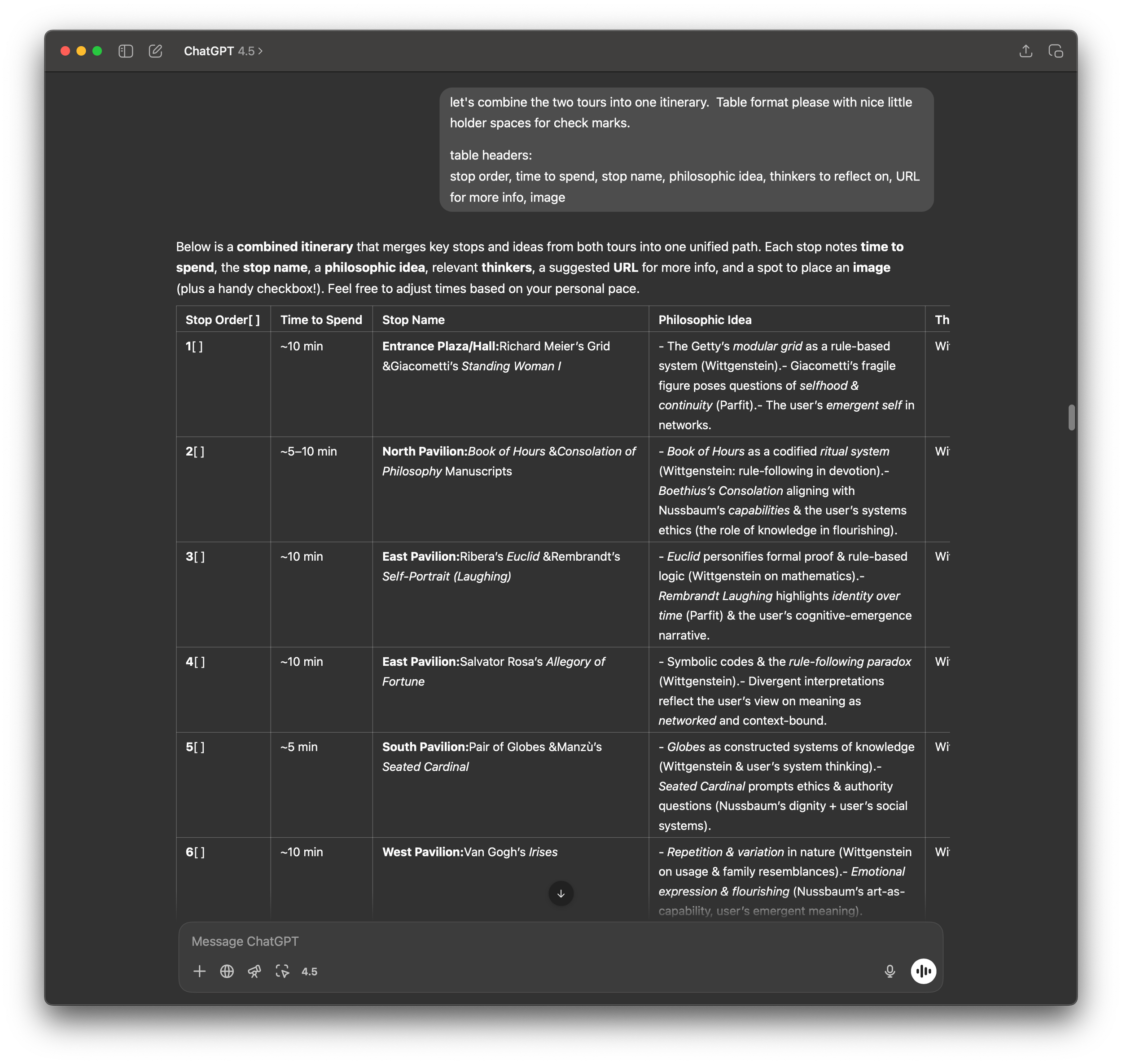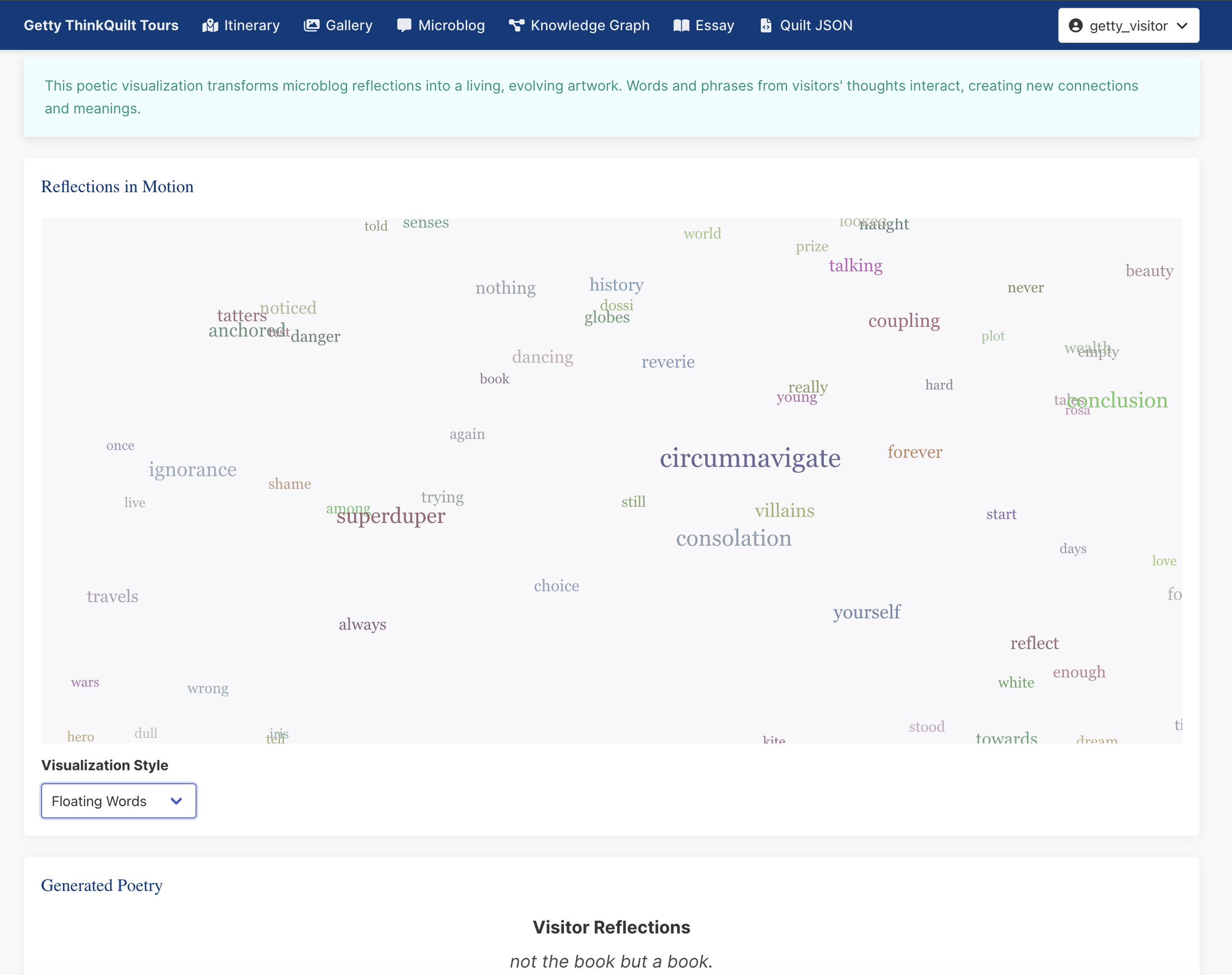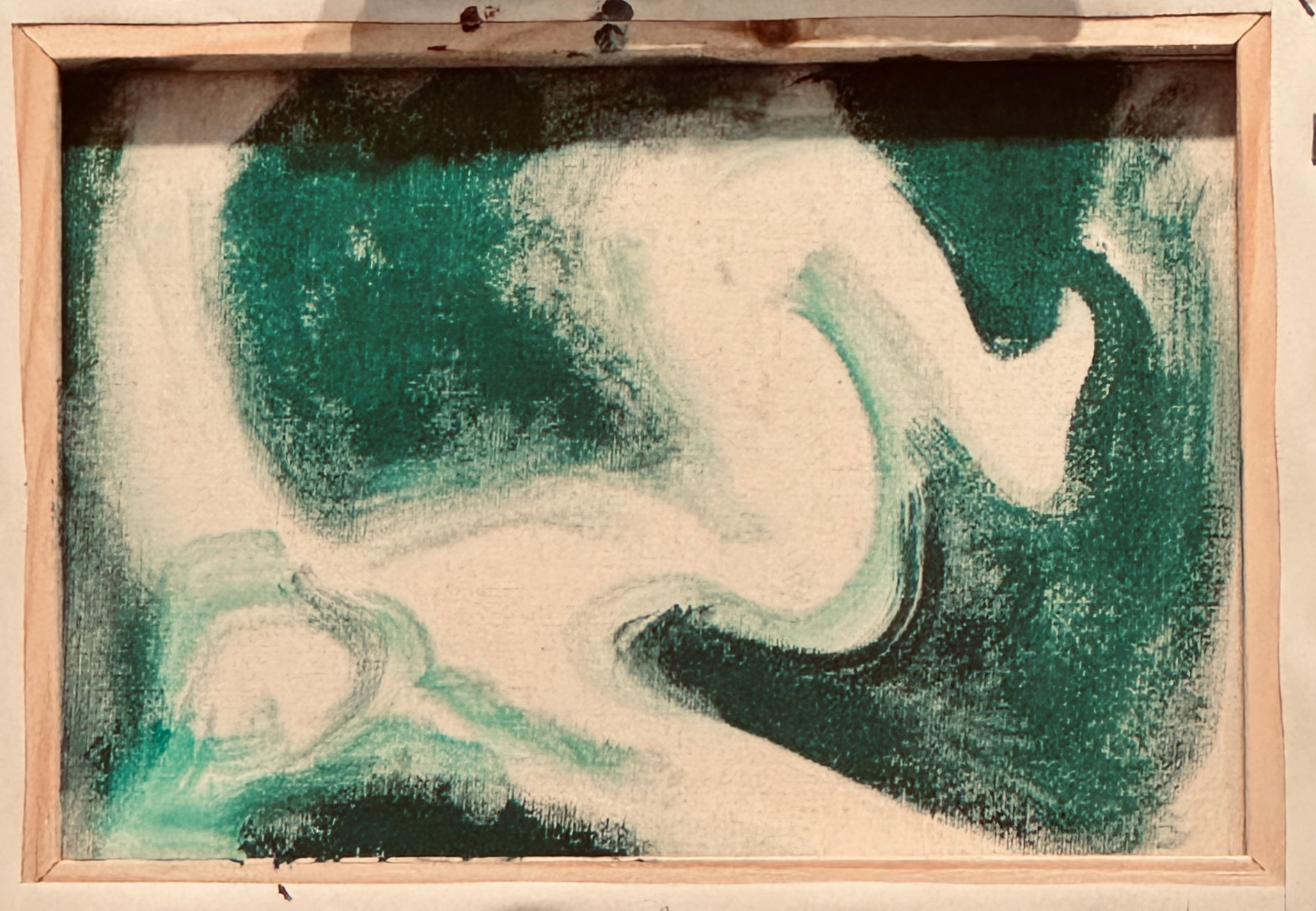Computational Quilting as Philosophy as Living

I QUILT, THEREFORE, I AM.
I went to the gym on Saturday and while “exercising” I had a thought.
chatGPT deep research should design a route through the Getty for me based on philosophers ideas I wanted to explore via art and space
So I tasked chatGPT with the assignment and I then finished “getting swoll”
The research compelled me to go further.
A good itinerary, makes for a better computational quilt!
AN APP FOr the Day Was Born.
Rather than leave straight away for the Getty to arrive by 10am opening I decided to just finish the obvious…. Why leave the house with just a static tour itinerary?
from chat to app
So an hour or less later I had a custom built for my Getty day interactive tour built around my philosophic quilt.
A Quilt Woven
chatGPT, Replit, Claude.ai, Wittgenstein, Nussbaum, Parfit, The Getty, all the artists, and the WWW wove a quilt of artistic experience. What started at 7:14am as an idea for how I’d experience the Getty for my bazillionth time was by noon a fully realized living quilt of ideas, computation, reflection, walking essay.
The Best Way to Experience The Getty
The INTINERARY
The Philosophical Journey Through the Getty
An Exploration of Identity, Ethics, Language, and Systems
The Getty Center creates a unique nexus where art, architecture, and landscape converge to illuminate philosophical concepts that have shaped human understanding. This essay explores how the Getty's collection and environment speak to fundamental questions of meaning, identity, ethics, and our relationship with systems of thought.
1. Entrance Plaza: Giacometti's Standing Woman I
Giacometti's elongated bronze figure stands as a meditation on the tension between presence and absence. The stark, attenuated form embodies Wittgenstein's concern with boundaries—what is said and what remains unspeakable. Like language in Wittgenstein's view, the figure exists as both material reality and gesture toward what cannot be fully captured.
The sculpture's uncertain stance—neither fully grounded nor completely transcendent—mirrors our own existential condition within rule-based systems. We are simultaneously defined by and struggling against the confines of language, social conventions, and institutional frameworks.
Key Question: How much of your identity is shaped by the systems of language and social rules you inherited versus what you've actively chosen?
2. North Pavilion: Book of Hours & Consolation of Philosophy
These manuscripts represent system-building at its most intricate. The Book of Hours structured devotional life through ritualized prayer, while Boethius's Consolation of Philosophy offered a framework for understanding suffering and virtue within a cosmic order.
Martha Nussbaum's work on capabilities and human flourishing finds resonance here. Both manuscripts present systems not as abstract impositions but as lived practices that expand human possibilities and create meaning. Flourishing, in Nussbaum's view, requires both structure and space for agency—precisely what these texts offered their users.
Key Question: What daily rituals or practices structure your own search for meaning, and how do they both constrain and liberate you?
3. East Pavilion: Ribera's Euclid & Rembrandt's Self-Portrait
Juxtaposing Ribera's portrait of Euclid with Rembrandt's self-portrait creates a profound dialogue about identity and knowledge. Euclid represents a system of formal proofs that transcend the individual, while Rembrandt's laughing self-portrait captures the irreducible particularity of personal experience.
Derek Parfit's revolutionary work on personal identity resonates here—his challenge to the idea of a continuous, stable self finds visual expression in Rembrandt's series of self-portraits over time. We see not a single "Rembrandt" but a succession of related states, connected by psychological continuity yet fundamentally different at each moment.
Key Question: If you were to create a series of self-portraits throughout your life, what would remain constant, and what would change fundamentally?
4. East Pavilion: Salvator Rosa's Allegory of Fortune
Rosa's allegorical painting depicts Fortune as a woman pouring riches from an urn while standing precariously on a sphere—embodying the instability of worldly success. This rich symbolic language creates a rule-based visual system that both communicates meaning and reflects on its own artifice.
Wittgenstein's explorations of the rule-following paradox find visual form here: the painting establishes rules for its own interpretation while simultaneously calling attention to the contingency of those very rules. The allegorical figures follow artistic conventions while subtly undermining their authority.
Key Question: When you encounter systems of meaning (artistic, religious, political), do you primarily find security in their structure or freedom in interpreting them?
5. South Pavilion: Pair of Globes & Manzù's Seated Cardinal
The juxtaposition of scientific globes with Manzù's modernist cardinal creates a dialogue between different systems of authority—empirical science and religious doctrine. Both represent human attempts to map experience and establish order, yet both remain fundamentally incomplete.
The tension between these objects illuminates Nussbaum's concern with ethical authority: who determines what constitutes human flourishing? The globes offer an external, seemingly objective perspective, while the cardinal represents institutionalized moral authority. Both systems structure human capability, yet neither can fully capture the complexity of lived experience.
Key Question: Which systems of authority do you grant legitimacy in your own life, and how do you navigate conflicts between them?
6. West Pavilion: Van Gogh's Irises
Van Gogh's Irises demonstrates how repetition and variation within a system generate not monotony but richness. Each iris follows the same botanical pattern yet emerges as unique—exemplifying how rule-following can produce not conformity but flourishing variety.
This tension between pattern and uniqueness speaks directly to both Wittgenstein's understanding of language games and Nussbaum's capabilities approach. For Van Gogh, the flowers participate in the "language game" of botanical forms while simultaneously transcending those forms through vibrant particularity, much as human flourishing requires both shared capabilities and individual expression.
Key Question: Where in your life do you find freedom within constraints, and how does structure enable rather than limit your creative expression?
7. Central Garden: Robert Irwin's Living Artwork
Irwin's garden embodies a dynamic system that evolves through time—plants grow, water flows, and visitors create paths. Unlike traditional artworks that remain fixed, this "sculpture in the form of a garden" exemplifies emergent meaning that arises from the interaction of multiple elements within a framework.
This living artwork powerfully illustrates Foltz-Smith's concepts of systems thinking and emergence. Meaning here isn't imposed from above but emerges through the interaction of components within the system. Similarly, our identities emerge not from a fixed essence but from the ongoing interaction of psychological states, social contexts, and physical embodiment.
Key Question: How has your identity emerged over time through interactions with others, rather than being determined by an unchanging essence?
8. Overlook: Perspective & Synthesis
From the Getty's overlook, Los Angeles stretches to the horizon—a complex system viewed from a unifying perspective. This vantage point offers not dominance over the city but a momentary integration of its complexity into a coherent whole.
This perspective embodies the philosophical journey itself: we move between immersion in particular experiences and moments of integrative understanding. Parfit's work on identity, Nussbaum's ethical framework, and Wittgenstein's analysis of language all attempt this movement between the particular and the whole, between lived experience and philosophical perspective.
Key Question: What perspectives or practices help you integrate the fragmentary experiences of your life into a meaningful whole?
Conclusion: Philosophy as Journey
The Getty Center, through its art, architecture, and landscape, offers not a single philosophical system but a journey through intersecting frameworks of meaning. Like visitors navigating its paths, we move between perspectives—sometimes dwelling in the particularity of experience, sometimes reaching for integrative understanding.
This journey reminds us that philosophical concepts aren't abstract ideas but ways of navigating lived experience. They offer not fixed answers but tools for questioning, frameworks for understanding, and paths for ongoing exploration. The philosophical journey, like the Getty visit itself, doesn't end with a definitive conclusion but opens into continuing reflection and discovery.
EUCLID, new to me.
One of the biggest surprises of this computational quilt was encountering a painting called “Euclid”.
I’ve walked by, probably glanced at, but never spent any time remembering this painting. What? Impossible. But really, I had never recalled seeing it. Even though I’ve been in e206 many many times.
Euclid
about 1630–1635
Jusepe de Ribera (Spanish / Italian, Spanish/ Italian, 1591 - 1652)
Euclid.
A New Getty, for me.
my getty quilt reflected back on me.
A FULLER QUILT
And with a couple hours to reflect a day later, the full quilt exists.
The Quilt Documents Itself
Overview
Getty ThinkQuilt is an interactive digital companion that enhances visitor experiences at the Getty Center by connecting art, architecture, and philosophical concepts. The application guides users through a thoughtfully curated journey that illuminates connections between artworks and philosophical frameworks, creating a deeper, more meaningful museum experience.
Core Features
1. Philosophical Tour Quilt System
Multiple Tour Options: Choose from several curated tours focusing on different aspects of the Getty Center (Standard Philosophical Tour, Art Focus Tour, Architecture Tour).
Interactive Stops: Each tour features specific stops with philosophical themes tied to artworks, architecture, and garden views.
Customizable Journeys: Users can create and share their own custom tour "quilts" to focus on specific philosophical frameworks.
2. Check-in/Check-out Experience
Location-based Engagement: Check in at each stop on your chosen tour.
Guided Reflection: Capture thoughts and insights through notes at each location.
Visual Memory: Take and store photos at each stop to document your experience.
Progress Tracking: Monitor your journey through completion indicators.
3. Social & Community Features
Microblog Timeline: Share reflections and images with the ThinkQuilt community.
Gallery of Memories: Browse photos taken throughout your Getty journey.
Creative Expression: Apply artistic filters and create collages from your photos.
4. Data Visualization
Concept Networks: View interactive visualizations of philosophical concepts discussed in microblog posts.
Word Clouds: Explore common themes and concepts emerging from community reflections.
Poetic Visualization: Experience AI-generated poetry based on visitor reflections.
Virtual Museum: View your photo memories in an immersive 3D gallery space.
Value to Visitors
Deeper Engagement: Transforms passive viewing into active philosophical exploration.
Meaningful Context: Provides frameworks to understand art beyond aesthetic appreciation.
Personal Documentation: Creates a lasting record of your Getty Center experience.
Guided Reflection: Prompts thoughtful consideration of how art connects to philosophical ideas.
Knowledge Building: Introduces visitors to philosophical concepts through tangible, visible examples.
Community Connection: Allows visitors to see how others have engaged with and interpreted the same works.
Value to The Getty
Extended Visit Impact: Deepens visitor engagement before, during, and after physical visits.
Educational Mission Support: Advances the Getty's commitment to art education and interpretation.
Visitor Data Insights: Provides anonymized data on which artworks and concepts resonate most with visitors.
Digital Expansion: Extends the Getty experience beyond physical visit limitations.
Community Building: Creates a community of engaged visitors who can share their experiences.
Cross-disciplinary Connections: Explicitly connects art history with philosophy, enhancing interdisciplinary exploration.
Value to Philosophers and Artists
Applied Philosophy: Demonstrates philosophical concepts through tangible, visual examples in art and architecture.
New Interpretative Frameworks: Offers fresh perspectives on how philosophical ideas manifest in artistic expression.
Community Feedback: Provides real-world responses to theoretical concepts through visitor reflections.
Collaborative Space: Creates dialogue between artistic and philosophical disciplines.
Teaching Resource: Serves as a resource for educators in both art and philosophy.
Inspiration Source: Offers new connections that might inspire further artistic or philosophical work.
Key Philosophical Frameworks
The application integrates several major philosophical frameworks:
Wittgenstein's concepts of rule-following, language games, and the limits of expression
Parfit's theories on personal identity and psychological continuity
Nussbaum's capabilities approach and theories of human flourishing
Foltz-Smith's ideas on systems thinking and emergent properties
Technical Features
Cloud-based Storage: Securely stores user data, photos, and reflections.
Multi-device Access: Access your journey from any device with a web browser.
JSON-based Tour Framework: Easily extensible system for creating new tours and experiences.
Real-time Updates: See community contributions and reflections as they happen.
Visualization Tools: Transforms user data into meaningful visual patterns.
How to Begin
Create an Account: Sign up with a simple username to track your progress.
Select a Tour: Choose from the available philosophical "quilts" or create your own.
Visit the Getty: Follow your selected tour, checking in at each stop.
Reflect & Document: Capture thoughts and photos throughout your journey.
Share & Explore: Contribute to the community through the microblog and explore others' insights.
Getty ThinkQuilt transforms museum visits from passive observation to active philosophical exploration, creating lasting value for visitors, the institution, and the broader community of thinkers and creators.























